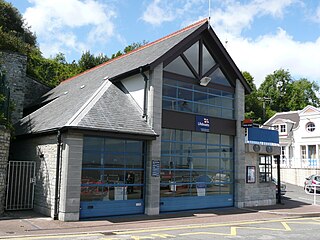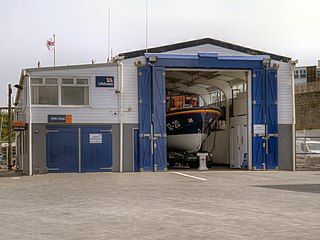
Mersey-class lifeboats are All-weather lifeboats operated by the Royal National Lifeboat Institution (RNLI) from stations around the coasts of Great Britain and Ireland, with three former RNLI boats operated by ADES Uruguay, and one by Bote Salvavidas de Valparaiso, Chile. They are capable of operating at up to 17 knots (31 km/h) and can be launched from a carriage or by slipway.

The Atlantic 85 is the third generation Rigid Inflatable Boat (RIB), in the B-class series of Inshore lifeboats, operated around the shores of the British Isles and the Channel Islands by the Royal National Lifeboat Institution (RNLI). Developed from the Atlantic 21 and the later Atlantic 75, it was first placed on service in 2005, and has gradually now replaced the older Atlantic 75-class. The Atlantic design of the B-class of lifeboats is named after Atlantic College, where the design was originally developed.

Penarth Lifeboat Station is located on the Esplanade in Penarth, Vale of Glamorgan, Wales.

Porthcawl Lifeboat Station is located at The Esplanade, in the town of Porthcawl, on the South Wales coast, in Bridgend, Wales.

Ilfracombe Lifeboat Station is the base for Royal National Lifeboat Institution (RNLI) search and rescue operations at Ilfracombe, Devon, England. The first lifeboat was stationed in the town in 1828 and the present station was opened in 1996. For 29 years a second boat was operated from Morte Bay at Woolacombe.

Minehead Lifeboat Station is the base for Royal National Lifeboat Institution (RNLI) search and rescue operations at Minehead, Somerset in England. The first lifeboat was stationed in the town in 1901 but since 1976 two inshore lifeboats (ILBs) have been operated, a B Class rigid-hulled boat and an inflatable D Class.

Burnham Area Rescue Boat (BARB), also known as BARB Search & Rescue, is a voluntary independent search and rescue service, formed in 1992 in Burnham-on-Sea, Somerset that operates two rescue hovercraft and two inshore rescue boats in the Bridgwater Bay area. It is a registered charity.

RNLB The Oddfellows (B-818) is the current rigid-inflatable inshore lifeboat on station at the English coastal town of Sheringham in the county of Norfolk in the United Kingdom.

Cardigan Lifeboat Station is located at Poppit Sands, on the southern side of the River Teifi estuary in North Pembrokeshire, approximately 3 miles (4.8 km) north-west of the town of Cardigan, Wales.

Margate Lifeboat Station is a Royal National Lifeboat Institution (RNLI) station located in Margate in the English county of Kent. The station is over 160 years old. Its crews have earned a number of gallantry awards, including five silver and 1 bronze RNLI medals for bravery.

Hunstanton Lifeboat Station is located in the village of Old Hunstanton, in the English county of Norfolk. It is the only lifeboat station on the east coast of England which faces westward, being positioned on the east side of the square-mouthed bay and estuary known as The Wash.

Hayling Island Lifeboat Station is located on the eastern side of Hayling Island, Hampshire, opposite the village of West Wittering, at the entrance to Chichester Harbour, where it joins the major shipping route of the Solent. This major shipping route is busy at all times of the year and there are estimated to be 10,000 boats in the Chichester area alone.

Talus MB-H is a continuous track launch tractor which was specifically designed for the Royal National Lifeboat Institution (RNLI), to launch and recover carriage mounted lifeboats, particularly the Mersey-class lifeboat, from beach-launched lifeboat stations. In total, 31 tractors were manufactured by Clayton Engineering Limited of Knighton, Powys.

Talus MB-4H is a four-wheel-drive launch tractor which was specifically designed for the Royal National Lifeboat Institution (RNLI), to launch and recover inshore lifeboats from beach launched lifeboat stations.

Talus MB-764 is a four-wheel drive launch tractor which was specifically designed for the RNLI, to launch and recover inflatable inshore lifeboats from beach and shorebased launched lifeboat stations. The Tractor is produced by the British company of Clayton Engineering Limited who are based in Knighton, Powys.

The New Holland TC45 is a four-wheel drive compact tractor, adapted to suit the launch and recovery requirements for some of the RNLI's inflatable inshore lifeboats from beach and shore-based lifeboat stations.

The Talus Atlantic 85 DO-DO launch carriage is a Drive On - Drive Off lifeboat launch and recovery carriage used by the RNLI to launch its Atlantic class inshore lifeboats.

Port Isaac Lifeboat Station is the base for Royal National Lifeboat Institution (RNLI) inshore lifeboat operations at Port Isaac in Cornwall, United Kingdom. It operates a D-class (IB1) lifeboat, which since 2019 has been the Pride of Port Isaac .

Shannon Launch and Recovery System (SLARS) is a custom designed tractor and trailer specifically designed for the Royal National Lifeboat Institution (RNLI) to launch and recover Shannon-class lifeboats.

Fowler Challenger III is a continuous track amphibious launch tractor, which was specifically designed for the Royal National Lifeboat Institution (RNLI), to launch and recover carriage mounted lifeboats, from beach-launched lifeboat stations.

























